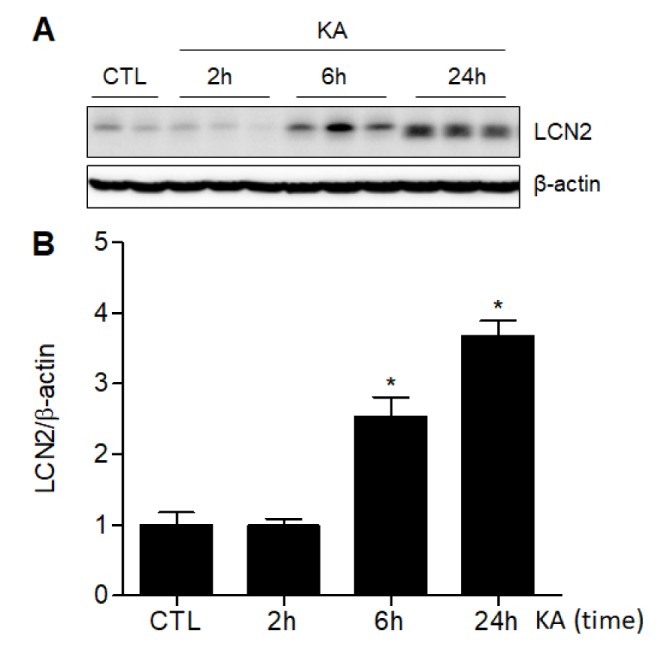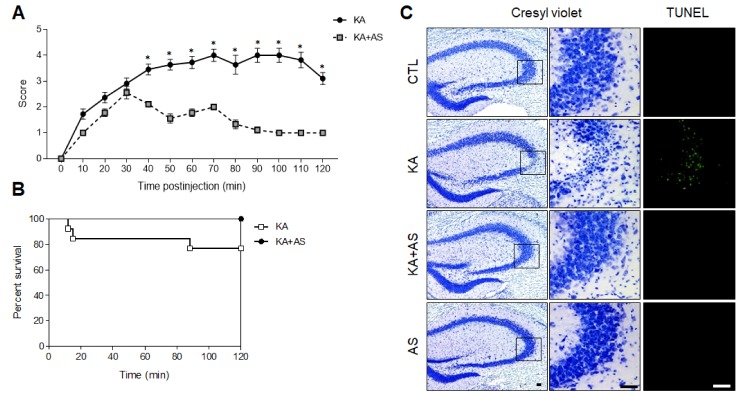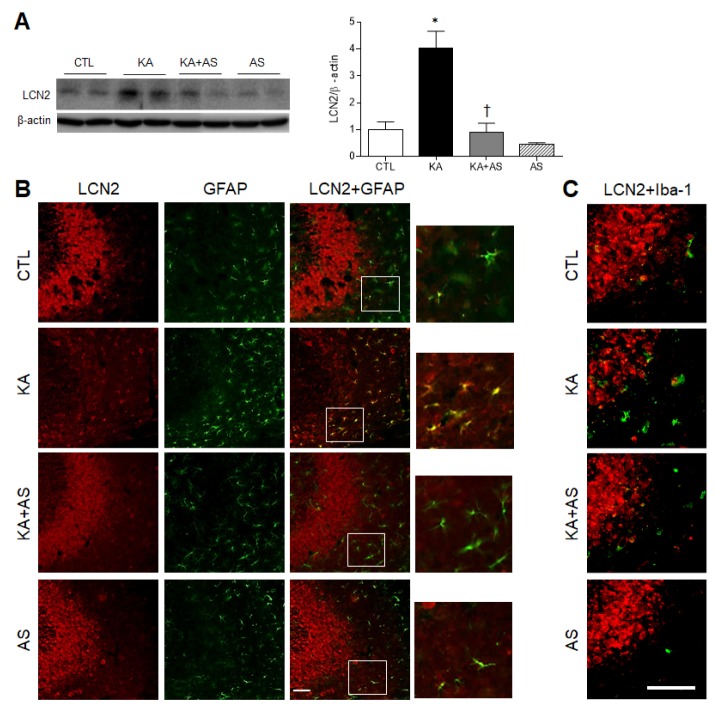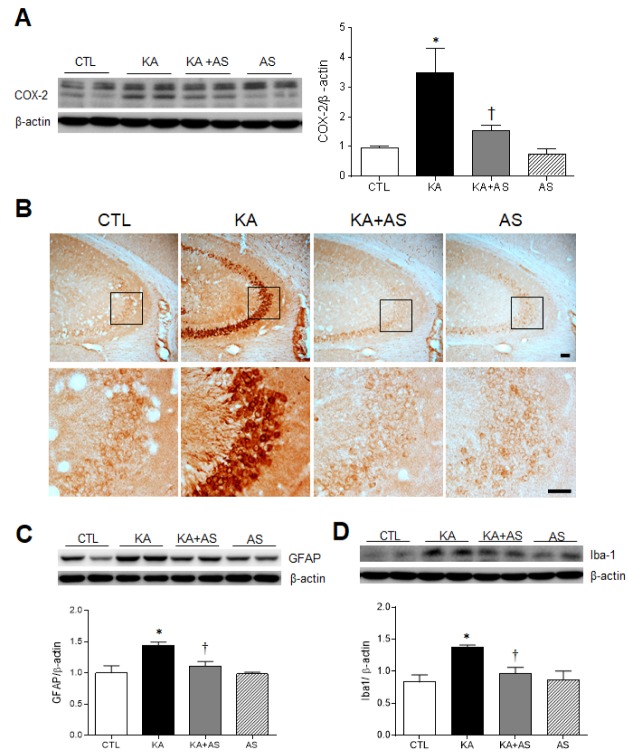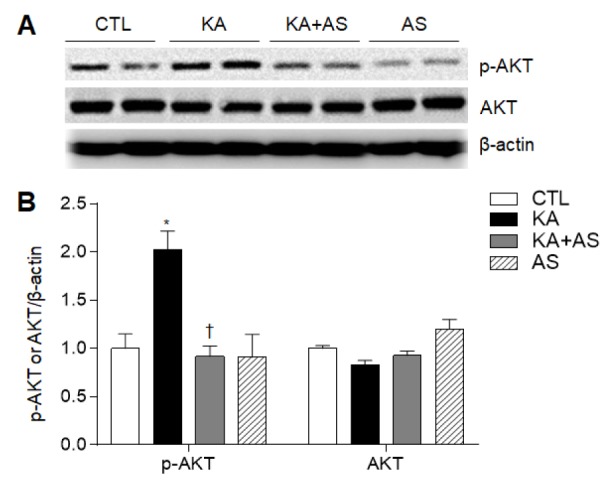Korean J Physiol Pharmacol.
2018 May;22(3):301-309. 10.4196/kjpp.2018.22.3.301.
Atorvastatin pretreatment attenuates kainic acid-induced hippocampal neuronal death via regulation of lipocalin-2-associated neuroinflammation
- Affiliations
-
- 1Department of Anatomy and Convergence Medical Science, Institute of Health Sciences, College of Medicine, Gyeongsang National University, Jinju 52727, Korea. anaroh@gnu.ac.kr
- 2Department of Neurology, Changwon Fatima Hospital, Changwon 51394, Korea.
- 3Department of Thoracic and Cardiovascular Surgery, Institute of Health Sciences, College of Medicine, Gyeongsang National University, Jinju 52727, Korea.
- 4Department of Neurology, Institute of Health Sciences, College of Medicine, Gyeongsang National University, Jinju 52727, Korea. ncchoi@nate.com
- KMID: 2410094
- DOI: http://doi.org/10.4196/kjpp.2018.22.3.301
Abstract
- Statins mediate vascular protection and reduce the prevalence of cardiovascular diseases. Recent work indicates that statins have anticonvulsive effects in the brain; however, little is known about the precise mechanism for its protective effect in kainic acid (KA)-induced seizures. Here, we investigated the protective effects of atorvastatin pretreatment on KA-induced neuroinflammation and hippocampal cell death. Mice were treated via intragastric administration of atorvastatin for 7 days, injected with KA, and then sacrificed after 24 h. We observed that atorvastatin pretreatment reduced KA-induced seizure activity, hippocampal cell death, and neuroinflammation. Atorvastatin pretreatment also inhibited KA-induced lipocalin-2 expression in the hippocampus and attenuated KA-induced hippocampal cyclooxygenase-2 expression and glial activation. Moreover, AKT phosphorylation in KA-treated hippocampus was inhibited by atorvastatin pretreatment. These findings suggest that atorvastatin pretreatment may protect hippocampal neurons during seizures by controlling lipocalin-2-associated neuroinflammation.
Keyword
MeSH Terms
Figure
Reference
-
1. McCord MC, Lorenzana A, Bloom CS, Chancer ZO, Schauwecker PE. Effect of age on kainate-induced seizure severity and cell death. Neuroscience. 2008; 154:1143–1153. PMID: 18479826.
Article2. Carta M, Fièvre S, Gorlewicz A, Mulle C. Kainate receptors in the hippocampus. Eur J Neurosci. 2014; 39:1835–1844. PMID: 24738709.
Article3. Ravizza T, Rizzi M, Perego C, Richichi C, Velísková J, Moshé SL, De Simoni MG, Vezzani A. Inflammatory response and glia activation in developing rat hippocampus after status epilepticus. Epilepsia. 2005; 46(Suppl 5):113–117. PMID: 15987264.
Article4. Kim JE, Ryu HJ, Choi SY, Kang TC. Tumor necrosis factor-α-mediated threonine 435 phosphorylation of p65 nuclear factor-κB subunit in endothelial cells induces vasogenic edema and neutrophil infiltration in the rat piriform cortex following status epilepticus. J Neuroinflammation. 2012; 9:6. PMID: 22240205.
Article5. Shin HJ, Jeon BT, Kim J, Jeong EA, Kim MJ, Lee DH, Kim HJ, Kang SS, Cho GJ, Choi WS, Roh GS. Effect of the calcineurin inhibitor FK506 on K+-Cl-cotransporter 2 expression in the mouse hippocampus after kainic acid-induced status epilepticus. J Neural Transm (Vienna). 2012; 119:669–677. PMID: 22160488.6. Xie WJ, Dong M, Liu Q, Meng HM. Early predictors and prevention for post-stroke epilepsy: changes in neurotransmitter levels. Transl Neurosci. 2016; 7:1–5. PMID: 28123814.
Article7. Ní Chróinín D, Asplund K, Åsberg S, Callaly E, Cuadrado-Godia E, Díez-Tejedor E, Di Napoli M, Engelter ST, Furie KL, Giannopoulos S, Gotto AM Jr, Hannon N, Jonsson F, Kapral MK, Martí-Fàbregas J, Martínez-Sánchez P, Milionis HJ, Montaner J, Muscari A, Pikija S, Probstfield J, Rost NS, Thrift AG, Vemmos K, Kelly PJ. Statin therapy and outcome after ischemic stroke: systematic review and meta-analysis of observational studies and randomized trials. Stroke. 2013; 44:448–456. PMID: 23287777.
Article8. Li Q, Zhuang QK, Yang JN, Zhang YY. Statins excert neuroprotection on cerebral ischemia independent of their lipid-lowering action: the potential molecular mechanisms. Eur Rev Med Pharmacol Sci. 2014; 18:1113–1126. PMID: 24817284.9. Pannu R, Christie DK, Barbosa E, Singh I, Singh AK. Post-trauma Lipitor treatment prevents endothelial dysfunction, facilitates neuroprotection, and promotes locomotor recovery following spinal cord injury. J Neurochem. 2007; 101:182–200. PMID: 17217414.
Article10. Lee JK, Won JS, Singh AK, Singh I. Statin inhibits kainic acid-induced seizure and associated inflammation and hippocampal cell death. Neurosci Lett. 2008; 440:260–264. PMID: 18583044.
Article11. Wang L, Zhang X, Liu L, Yang R, Cui L, Li M. Atorvastatin protects rat brains against permanent focal ischemia and downregulates HMGB1, HMGB1 receptors (RAGE and TLR4), NF-kappaB expression. Neurosci Lett. 2010; 471:152–156. PMID: 20100543.12. Goetz DH, Holmes MA, Borregaard N, Bluhm ME, Raymond KN, Strong RK. The neutrophil lipocalin NGAL is a bacteriostatic agent that interferes with siderophore-mediated iron acquisition. Mol Cell. 2002; 10:1033–1043. PMID: 12453412.
Article13. Devireddy LR, Gazin C, Zhu X, Green MR. A cell-surface receptor for lipocalin 24p3 selectively mediates apoptosis and iron uptake. Cell. 2005; 123:1293–1305. PMID: 16377569.
Article14. Flo TH, Smith KD, Sato S, Rodriguez DJ, Holmes MA, Strong RK, Akira S, Aderem A. Lipocalin 2 mediates an innate immune response to bacterial infection by sequestrating iron. Nature. 2004; 432:917–921. PMID: 15531878.
Article15. Lee S, Kim JH, Kim JH, Seo JW, Han HS, Lee WH, Mori K, Nakao K, Barasch J, Suk K. Lipocalin-2 is a chemokine inducer in the central nervous system: role of chemokine ligand 10 (CXCL10) in lipocalin-2-induced cell migration. J Biol Chem. 2011; 286:43855–43870. PMID: 22030398.16. Jin M, Kim JH, Jang E, Lee YM, Soo Han H, Woo DK, Park DH, Kook H, Suk K. Lipocalin-2 deficiency attenuates neuroinflammation and brain injury after transient middle cerebral artery occlusion in mice. J Cereb Blood Flow Metab. 2014; 34:1306–1314. PMID: 24780901.
Article17. Lee S, Park JY, Lee WH, Kim H, Park HC, Mori K, Suk K. Lipocalin-2 is an autocrine mediator of reactive astrocytosis. J Neurosci. 2009; 29:234–249. PMID: 19129400.
Article18. Sehar N, Agarwal NB, Vohora D, Raisuddin S. Atorvastatin prevents development of kindling by modulating hippocampal levels of dopamine, glutamate, and GABA in mice. Epilepsy Behav. 2015; 42:48–53. PMID: 25499163.
Article19. Funck VR, de Oliveira CV, Pereira LM, Rambo LM, Ribeiro LR, Royes LF, Ferreira J, Guerra GP, Furian AF, Oliveira MS, Mallmann CA, de Mello CF, Oliveira MS. Differential effects of atorvastatin treatment and withdrawal on pentylenetetrazol-induced seizures. Epilepsia. 2011; 52:2094–2104. PMID: 21906051.
Article20. Hu RQ, Koh S, Torgerson T, Cole AJ. Neuronal stress and injury in C57/BL mice after systemic kainic acid administration. Brain Res. 1998; 810:229–240. PMID: 9813346.
Article21. Kang DH, Heo RW, Yi CO, Kim H, Choi CH, Roh GS. High-fat diet-induced obesity exacerbates kainic acid-induced hippocampal cell death. BMC Neurosci. 2015; 16:72. PMID: 26518260.
Article22. Mucha M, Skrzypiec AE, Schiavon E, Attwood BK, Kucerova E, Pawlak R. Lipocalin-2 controls neuronal excitability and anxiety by regulating dendritic spine formation and maturation. Proc Natl Acad Sci U S A. 2011; 108:18436–18441. PMID: 21969573.
Article23. Skrzypiec AE, Shah RS, Schiavon E, Baker E, Skene N, Pawlak R, Mucha M. Stress-induced lipocalin-2 controls dendritic spine formation and neuronal activity in the amygdala. PLoS One. 2013; 8:e61046. PMID: 23593384.
Article24. Jeong EA, Jeon BT, Shin HJ, Kim N, Lee DH, Kim HJ, Kang SS, Cho GJ, Choi WS, Roh GS. Ketogenic diet-induced peroxisome proliferator-activated receptor-γ activation decreases neuroinflammation in the mouse hippocampus after kainic acid-induced seizures. Exp Neurol. 2011; 232:195–202. PMID: 21939657.
Article25. Chen J, Zhang ZG, Li Y, Wang Y, Wang L, Jiang H, Zhang C, Lu M, Katakowski M, Feldkamp CS, Chopp M. Statins induce angiogenesis, neurogenesis, and synaptogenesis after stroke. Ann Neurol. 2003; 53:743–751. PMID: 12783420.
Article26. Piermartiri TC, Vandresen-Filho S, de Araújo Herculano B, Martins WC, Dal'agnolo D, Stroeh E, Carqueja CL, Boeck CR, Tasca CI. Atorvastatin prevents hippocampal cell death due to quinolinic acid-induced seizures in mice by increasing Akt phosphorylation and glutamate uptake. Neurotox Res. 2009; 16:106–115. PMID: 19526287.
Article27. Pursnani A, Massaro JM, D'Agostino RB Sr, O'Donnell CJ, Hoffmann U. Guideline-based statin eligibility, coronary artery calcification, and cardiovascular events. JAMA. 2015; 314:134–141. PMID: 26172893.
Article28. Castilla-Guerra L, Fernández-Moreno Mdel C, López-Chozas JM. Statins in the secondary prevention of stroke: New evidence from the SPARCL Study. Clin Investig Arterioscler. 2016; 28:202–208.29. Takemoto M, Yokote K. Prevention, treatment and management of inflammation in atherosclerosis. Nihon Rinsho. 2011; 69:18–24. PMID: 21226254.30. Wood WG, Mΰller WE, Eckert GP. Statins and neuroprotection: basic pharmacology needed. Mol Neurobiol. 2014; 50:214–220. PMID: 24474514.
Article31. Ramirez C, Tercero I, Pineda A, Burgos JS. Simvastatin is the statin that most efficiently protects against kainate-induced excitotoxicity and memory impairment. J Alzheimers Dis. 2011; 24:161–174.
Article32. Gouveia TL, Scorza FA, Silva MJ, Bandeira Tde A, Perosa SR, Argañaraz GA, Silva Mde P, Araujo TR, Frangiotti MI, Amado D, Cavalheiro EA, Silva JA Jr, Naffah-Mazzacoratti Mda G. Lovastatin decreases the synthesis of inflammatory mediators in the hippocampus and blocks the hyperthermia of rats submitted to longlasting status epilepticus. Epilepsy Behav. 2011; 20:1–5. PMID: 21130693.
Article33. Saito T, Nito C, Ueda M, Inaba T, Kamiya F, Muraga K, Katsura K, Katayama Y. Continuous oral administration of atorvastatin ameliorates brain damage after transient focal ischemia in rats. Life Sci. 2014; 94:106–114. PMID: 24333133.
Article34. Chia WJ, Dawe GS, Ong WY. Expression and localization of the iron-siderophore binding protein lipocalin 2 in the normal rat brain and after kainate-induced excitotoxicity. Neurochem Int. 2011; 59:591–599. PMID: 21683107.
Article35. Jang E, Lee S, Kim JH, Kim JH, Seo JW, Lee WH, Mori K, Nakao K, Suk K. Secreted protein lipocalin-2 promotes microglial M1 polarization. FASEB J. 2013; 27:1176–1190. PMID: 23207546.
Article36. Lee S, Lee J, Kim S, Park JY, Lee WH, Mori K, Kim SH, Kim IK, Suk K. A dual role of lipocalin 2 in the apoptosis and deramification of activated microglia. J Immunol. 2007; 179:3231–3241. PMID: 17709539.
Article37. Xing C, Wang X, Cheng C, Montaner J, Mandeville E, Leung W, van Leyen K, Lok J, Wang X, Lo EH. Neuronal production of lipocalin-2 as a help-me signal for glial activation. Stroke. 2014; 45:2085–2092. PMID: 24916903.
Article38. Fukunaga K, Kawano T. Akt is a molecular target for signal transduction therapy in brain ischemic insult. J Pharmacol Sci. 2003; 92:317–327. PMID: 12939516.
Article39. Dunleavy M, Provenzano G, Henshall DC, Bozzi Y. Kainic acid-induced seizures modulate Akt (SER473) phosphorylation in the hippocampus of dopamine D2 receptor knockout mice. J Mol Neurosci. 2013; 49:202–210. PMID: 23188702.
Article40. Noshita N, Lewén A, Sugawara T, Chan PH. Akt phosphorylation and neuronal survival after traumatic brain injury in mice. Neurobiol Dis. 2002; 9:294–304. PMID: 11950275.
Article41. Kawano T, Fukunaga K, Takeuchi Y, Morioka M, Yano S, Hamada J, Ushio Y, Miyamoto E. Neuroprotective effect of sodium orthovanadate on delayed neuronal death after transient forebrain ischemia in gerbil hippocampus. J Cereb Blood Flow Metab. 2001; 21:1268–1280. PMID: 11702042.
Article
- Full Text Links
- Actions
-
Cited
- CITED
-
- Close
- Share
- Similar articles
-
- Cilostazol attenuates kainic acid-induced hippocampal cell death
- Intracerebroventricular Kainic Acid-Induced Damage Affects Blood Glucose Level in d-glucose-fed Mouse Model
- Kainic Acid-induced Neuronal Death is Attenuated by Aminoguanidine but Aggravated by L-NAME in Mouse Hippocampus
- Effects of Ascorbic and Dehydroascorbic Acids on Apoptotic Cell Death in Hippocampal Slice Culture
- Curcumin Attenuates Glial Cell Activation But Cannot Suppress Hippocampal CA3 Neuronal Cell Death in i.c.v. Kanic Acid Injection Model

